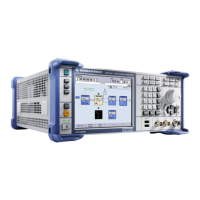Instrument Function
R&S
®
SMBV100A
141Operating Manual 1176.8016.02 ─ 17
Remote command:
[:SOURce]:INPut:CLOCk:IMPedance on page 742
Baseband Trigger Input Slope
Selects the polarity of the active slope of an externally applied trigger signal.
This setting affects the INST TRIG input connector (BNC connector at the rear of the
instrument).
Remote command:
[:SOURce]:INPut:TRIGger:BBANd:SLOPe on page 743
Ext. Trigger Input Slope
Sets the polarity of the active slope of an externally applied instrument trigger.
This setting affects the TRIG input (BNC connector at the rear of the instrument).
"Positive"
activates the rising edge of the trigger signal.
"Negative"
activates the falling edge of the trigger signal.
Remote command:
[:SOURce]:INPut:TRIGger:SLOPe on page 744
Clock Input Slope
Sets the polarity of the active slope of an externally applied symbol clock pulse.
This setting affects the CLOCK input (BNC connector).
Remote command:
:CLOCk:INPut:SLOPe on page 549
Automatic Delay Compensation
While working in a master-slave mode, the instruments are connected as daisy chain
(see also Chapter 5.9.2.4, "Synchronous Signal Generation", on page 329). The set-
tings for automatic delay compensation enable each of the slaves to calculate and
compensate the expected timing delay caused by the used cables. The calculation
assumes an ordinary BNC cables that have a dielectrics with a permittivity of Ɛr = 2.7.
General Instrument Settings

